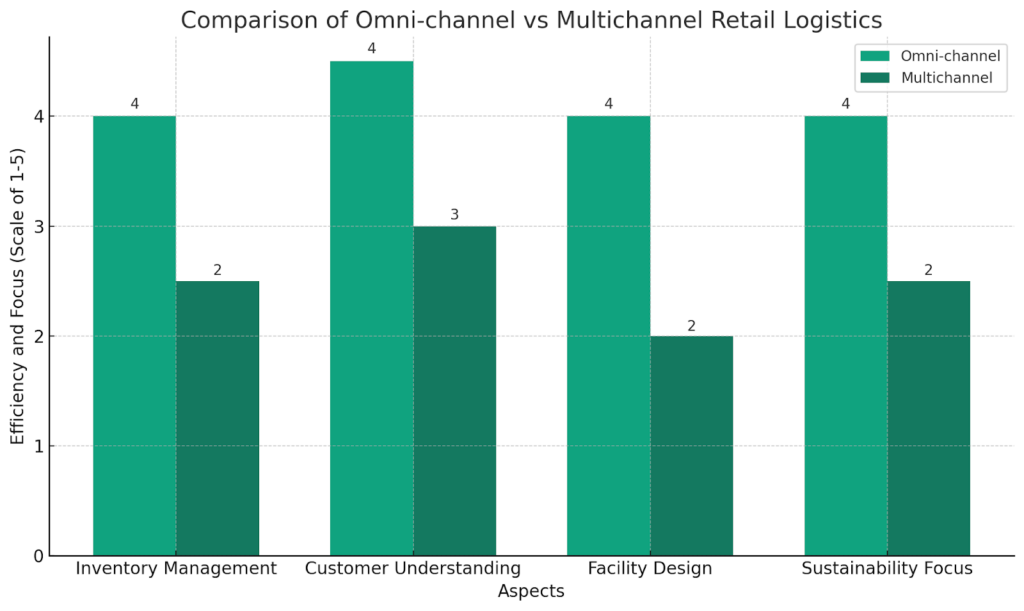In the ever-evolving retail landscape, a paradigm shift is underway – the rise of omni-channel logistics. This concept has become a cornerstone in modern retail strategy, reshaping how businesses approach customer service and supply chain management. Omni-channel logistics represents a holistic approach that seamlessly integrates various sales and distribution channels to provide a unified customer experience. This article is dedicated to unraveling the complexities of omni-channel logistics, highlighting its critical role in the current retail environment, and providing insights into effective implementation strategies.
The shift to omni-channel logistics marks a significant departure from traditional retail models that operated in silos. Today, retailers are embracing a more integrated approach, where online and offline channels complement each other, creating a cohesive shopping experience for customers. This transition is not just about technological adoption; it’s a strategic move towards customer-centricity, where convenience, speed, and flexibility are paramount.
As we delve deeper into this topic, our objective is to offer a comprehensive understanding of omni-channel logistics. We will explore how this approach is not merely an operational change but a strategic imperative that drives retail success in the digital age. The implementation of omni-channel logistics is a journey towards enhancing customer satisfaction, optimizing supply chain efficiency, and ultimately achieving sustainable business growth.
Understanding Omni-channel Logistics
Defining Omni-channel Logistics
Omni-channel logistics is an integrated approach to managing and delivering goods that spans across multiple sales channels. Unlike traditional logistics models, which often treated online and offline channels separately, omni-channel logistics focuses on creating a cohesive, consistent experience for customers regardless of how and where they choose to shop. This strategy involves synchronizing inventory, logistics operations, and distribution methods to ensure a seamless transition between online and physical shopping environments.
The Role of Omni-channel in Retail Success
In today’s retail scenario, omni-channel logistics is not just an option; it’s a necessity for success. This approach directly impacts customer satisfaction by offering flexible purchasing and delivery options, such as buy online and pick up in-store (BOPIS), easy returns, and real-time inventory visibility. Such capabilities enhance the shopping experience, leading to increased customer loyalty and repeat business. Furthermore, omni-channel logistics allows retailers to leverage data from various channels to better understand customer preferences and shopping patterns, enabling more targeted marketing and personalized services.
Integrating Physical and Digital Channels
The integration of physical and digital channels is at the heart of omni-channel logistics. This integration ensures that customers receive a consistent brand experience whether they shop online, in-store, or through mobile apps. Implementing this requires a robust technological infrastructure that can track and manage inventory across different channels in real-time, as well as logistics solutions that can adapt to various delivery and fulfillment scenarios. The goal is to create a seamless flow of goods and information across all customer touchpoints, making shopping a convenient and enjoyable experience.
Implementing Omni-channel Logistics in Retail
Assessment of Current Logistics Strategy
Implementing an effective omni-channel logistics strategy begins with a comprehensive assessment of your current logistics operations. Retailers need to evaluate how their existing supply chain and distribution models function across various channels. This involves analyzing inventory management practices, delivery and fulfillment processes, and the integration of digital platforms with physical stores. Identifying gaps, inefficiencies, or inconsistencies in these areas is crucial. Retailers should also assess customer feedback to understand pain points in the current shopping experience. This initial evaluation will set the foundation for developing a cohesive omni-channel strategy that aligns with both business objectives and customer expectations.
Developing an Omni-channel Logistics Plan
Creating an omni-channel logistics plan involves several key steps:
- Technology Adoption: Integrating advanced technologies is crucial for synchronizing operations across channels. This includes investing in an integrated inventory management system, utilizing robust eCommerce platforms, and adopting customer relationship management (CRM) tools.
- Process Optimization: Streamline logistics processes to ensure efficiency across all channels. This might involve reconfiguring warehouse operations, optimizing distribution routes, or implementing automated systems for order processing and fulfillment.
- Channel Integration: Ensure seamless integration between digital and physical channels. This could mean aligning online and in-store inventory systems, offering flexible delivery options like BOPIS (Buy Online, Pick-up In-Store), or enabling easy online returns in physical locations.
- Staff Training and Change Management: Educate your staff about the new omni-channel strategy and processes. Effective training and change management are essential for smooth implementation and adoption.
Execution and Continuous Improvement
Implementing an omni-channel logistics strategy requires careful planning and execution. Start with pilot projects or roll out changes in phases to monitor effectiveness and make necessary adjustments. Post-implementation, it’s vital to continuously monitor performance metrics and gather customer feedback. This ongoing evaluation helps in identifying areas for improvement and ensures that the omni-channel logistics strategy remains aligned with evolving customer needs and market trends.
Redefining Retail Logistics: The Omni-channel vs Multichannel Approach

In the rapidly evolving retail landscape, the strategic pivot from Multichannel to Omni-channel logistics represents a significant transformation. As depicted in the bar chart, Omni-channel logistics outperforms Multichannel across several critical dimensions.
Inventory Management: Omni-channel scores higher due to its integrated approach, allowing for real-time inventory management across all channels, significantly reducing stock discrepancies and enhancing product availability.
Customer Understanding: The Omni-channel model offers a more granular understanding of customer preferences, utilizing data from various channels. This contrasts with the more segmented approach of Multichannel logistics, which may not capture the full spectrum of customer behavior.
Facility Design: In terms of facility design, Omni-channel logistics promotes the optimization of distribution centers to serve multiple channels efficiently. In contrast, Multichannel logistics often requires separate facilities for online and offline channels, leading to increased costs and complexity.
Sustainability Focus: Omni-channel logistics also takes the lead in sustainability. The integration of various channels under a single system allows for more efficient use of resources and facilitates the adoption of sustainable practices such as smart energy management and reduced carbon footprint.
This comparison underscores the strategic advantages of Omni-channel logistics in today’s retail sector. By offering a more cohesive, efficient, and sustainable approach, Omni-channel logistics not only enhances the customer experience but also drives operational excellence, positioning retailers for success in a competitive market.
Key Strategies for Effective Omni-channel Logistics
- Seamless Inventory Management: Synchronized inventory management across all channels is vital. Implement an integrated system that provides real-time visibility and control over inventory, reducing stock discrepancies and ensuring product availability.
- Leveraging Technology for Efficiency: Embrace technologies such as AI for predictive analytics, IoT for enhanced tracking, and big data analytics for deeper insights into customer behavior. These technologies can streamline operations and provide a more personalized shopping experience.
- Customer-Centric Delivery and Returns: Develop flexible and convenient delivery and returns policies. Offering options like same-day delivery, easy in-store returns for online purchases, and automated return processes can significantly enhance customer satisfaction.
- Collaboration with Third-Party Logistics (3PL): Partnering with 3PL providers can offer expertise and resources in managing complex logistics operations, especially in areas like last-mile delivery or international shipping.
- Adopting Sustainable Practices: Implement eco-friendly logistics practices, such as using sustainable packaging materials, optimizing delivery routes for fuel efficiency, and recycling initiatives. Sustainability is increasingly important to modern consumers.
- Personalizing Customer Experiences: Utilize data analytics to offer personalized shopping experiences. This includes personalized product recommendations, tailored marketing messages, and customized delivery options based on customer preferences.
- Cross-Functional Collaboration: Ensure that all departments, from IT to customer service, work cohesively towards the omni-channel goal. Collaboration across functions is key to delivering a consistent and seamless customer experience.
- Continuous Innovation and Adaptation: Stay abreast of emerging trends and technologies in logistics and retail. Continuously innovate and adapt your omni-channel strategy to meet changing market demands and customer expectations.
By implementing these strategies, retailers can build a robust omni-channel logistics framework that not only meets the current demands of consumers but also positions them for future growth and success in the competitive retail landscape.
The Future of Retail and Omni-channel Logistics
Emerging Trends in Omni-channel Retail
The retail landscape is continually evolving, and omni-channel logistics stands at the forefront of this transformation. Key emerging trends include the integration of advanced technologies such as AI and IoT to enhance customer experience and operational efficiency. We’re witnessing a surge in the use of data analytics for personalized shopping experiences and predictive inventory management. Another significant trend is the blurring lines between physical and digital channels, leading to innovative concepts like virtual showrooms and augmented reality (AR) in shopping.
Challenges and Opportunities
While omni-channel logistics presents numerous opportunities for growth and innovation, it also brings challenges. One of the major challenges is the integration of various channels to provide a seamless customer experience. Retailers must overcome technological and operational hurdles to synchronize online and offline channels effectively. However, these challenges also open doors to opportunities such as expanded market reach, enhanced customer loyalty, and increased sales through multiple channels.
Sustainability in Omni-channel Logistics
Sustainability is becoming increasingly crucial in omni-channel logistics. Retailers are focusing on reducing their carbon footprint through eco-friendly packaging, optimizing delivery routes for fuel efficiency, and implementing green warehousing practices. Sustainable omni-channel logistics not only appeals to environmentally conscious consumers but also contributes to long-term cost savings and compliance with regulatory standards.
FAQs on Omni-channel Logistics in Retail
What are the primary benefits of omni-channel logistics in retail?
The key benefits include improved customer experience, increased sales, better inventory management, and enhanced brand loyalty.
What are the major challenges in implementing omni-channel logistics?
Challenges include integrating different sales channels, managing inventory across multiple platforms, and ensuring a consistent brand experience.
What are some best practices for successful omni-channel logistics?
Best practices involve investing in the right technology, focusing on data-driven decision-making, training staff for omni-channel operations, and maintaining a customer-centric approach.
Expert Insights and Practical Tips
Expert Insight: To succeed in omni-channel logistics, retailers should focus on creating a seamless transition between online and offline channels, prioritizing customer convenience at every touchpoint.
Practical Tip: Regularly analyze customer data to understand shopping behavior across channels and adjust your logistics strategy accordingly. This data-driven approach is key to meeting customer expectations and optimizing operations.
In conclusion, omni-channel logistics is not just an operational strategy; it’s a critical component for future success in the retail industry. As we’ve explored, the integration of various sales channels, leveraging emerging technologies, and focusing on sustainability are vital aspects of this approach. The shift to omni-channel logistics requires overcoming significant challenges, but it also opens up a world of opportunities for innovation and growth. Retailers who successfully navigate this transition will be well-positioned to thrive in the increasingly competitive and dynamic retail landscape. Embracing omni-channel logistics is embracing the future of retail – a future where flexibility, customer centricity, and efficiency are paramount.

